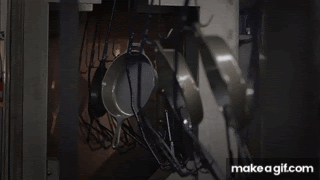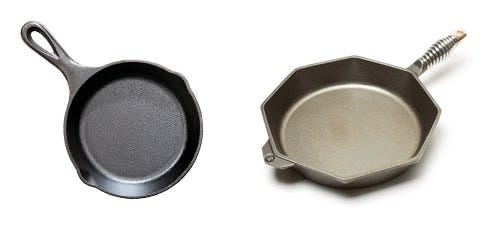There’s no shortage of things for people to fight about on the internet. Even the most innocent topics, like cast iron cookware, can spawn debate (and memes). A recent Vice article jumped into the fray and asked, “Is cast iron clout worth the hype, or just cookware elitism”? It got me thinking about some of the “Made in USA” cast iron pans in my kitchen drawer. The ones with a little egg-in-a-pan logo. What’s the story behind them? As it turns out, Lodge Cast Iron is a great example of a product and company that has been consistent while innovating and scaling in its own, considered, way.
Design
Cast iron cookware wasn’t new or novel when Joseph Lodge decided to open a foundry (a facility for melting/pouring metals into castings) in South Pittsburg, Tennessee in 1896. The origins of cast iron cookware date back to around the Iron Age period in China (~600 BC) and the first foundry in America was opened in 1642 by “European steelmakers” in Massachusetts. However, Joseph had a vision for establishing a foundry located close to the fuel (coke, a refined coal) and raw materials (iron) that were being mined in the Sequachee Valley and along the Tennessee river. Originally called Blacklock Foundry, Joseph Lodge produced a variety of cast iron products, including cookware. Cast iron cookware’s durability and ability to be used on the stove, in the oven, or over the fire has helped it remain a practical choice for centuries.
The shape and design of Lodge’s cast iron pans was unremarkable from other manufacturers and followed a consistent form. Lodge points out that their “product catalog has changed numerous times in our 121 years of business, but there’s one design element that appears in every single one of them: the teardrop shape of our cast iron skillet handle.” A minor, but signature, design element.

Innovation
What is most remarkable about Lodge is that they are still in business and producing the same product, all while being owned and operated within the same family and located in the same small community where it all started over 120 years ago. The Lodge story reminds me of another company we explored last year in a previous edition of Considered: Walker’s Shortbread. Again, a simple core product offering, family owned and operated for generations in the same community where it all started. Somehow both have survived and grown into global brands.
A fantastic article by The Bitter Southerner goes deep into the pride and emotional attachment the family operators of Lodge have with their business and community. Lodge’s CEO, Bob Kellerman (Joseph Lodge’s great grandson) reflects,
“People have asked me over the years, ‘How have we survived as a 120-year-old family brand?’... I guess I boil it down to four things: innovation, unwavering commitment to quality, reinvestment and dedicated, passionate people. We stayed up with the times.”
“Staying up with the times” means that Lodge has adapted its production process with more mechanization in an effort to increase production, manage costs, as well as shift its fuel source to electricity to reduce their environmental impact. However, one of the greatest innovations has been their pioneering development of “pre-seasoned” cast iron.
Seasoning is how a cast iron pan becomes non-stick. Teflon or other non-stick coatings have molecules so tightly bonded (smoothe) that it is impossible for anything to grip between them and stick. Seasoning has a different outcome. To season a metal (and it has to be a metal), you apply a fat to it and heat it until the molecules in the fat bond together to form polymers. This process makes the oil hard and water repellant, creating a non-stick surface.
In response to new generations of consumers that were less familiar or comfortable with seasoning, Lodge developed a seasoning process that they could do at the plant. The new Lodge cookware was ready to use out of the box. When released in 2002, the tag line for the pre-seasoned pans was “We should have thought of this 100 years ago". An industry first when introduced, the process has now been adapted as industry standard and is credited with growing overall interest and use of cast iron cookware by younger generations.
There are some who claim that these modern shifts have resulted in a slightly different or inferior product compared to what used to be manufactured by Lodge. Criticisms about the pans being thicker and heavier and less smooth in texture can be found online, but as with any internet debate, there are many who believe the product to be still of high quality and that it performs just as well as they vintage pans.
Sustainability
There aren’t many objects that can be used on a daily basis and then be passed on to multiple generations, but a cast iron is one of them. While resource and energy intensive in production, the durability and longevity makes it arguably more sustainable than other cookware materials like aluminum or stainless steel.
The main components of cast iron are pretty simple: pig iron, recycled stainless steel and recycled castings from the factory (left over bits from previous castings, or quality control rejects). These get melted together and poured as molten metal into moulds made from sand, water and clay. Once cooled into the desired shape, the cast iron is separated from the sand mould and the mould sand is used again for additional moulds.
In other methods of creating non stick pans, you are dealing with a host of toxic chemicals that can flake from your cookware and leach into your foods. The only thing that might leach into your food from cast iron is some of the flavour of the last thing you cooked in it.
I was really struck by how transparent Lodge is about its manufacturing process and facilities in South Pittsburg, Tennessee. Through their website and YouTube videos, you can see every step of the manufacturing process. If you really want to go deep, plan yourself a trip down to the National Cornbread Festival held in South Pittsburg every April and take a plant tour during their open house. When you employ ~500 people in a town of 3,000 and have been doing business for multiple generations, perhaps this is just the way to do business.
Much of the debate online is about how to treat your cast iron so the seasoning does not wear or wash off. There are specialty cleaning products that look like a swatch of medieval armour and rules about never using soap or cooking something acidic (tomatoes, etc) in cast iron. This America’s Test Kitchen article does a great job debunking most cast iron “myths.”

Value
Lodge cast iron pans generally find their way to the top of most “top cast iron” review lists, including The New York Time’s The Wirecutter. They also can be found seemingly everywhere, from local kitchen supply stores, to Amazon, Walmart and Costco priced around the $15-60 range depending on the size. As Lodge CEO, Bob Kellermann, puts it,
“Where else can you find an item for $20 bucks that will cook anything and everything and last a lifetime”?
If you’re looking for a bargain, the second hand market isn’t likely to help you out. Vintage cast iron are sought after collectibles and prices tend to be even higher for previously loved skillets. If you’re lucky and willing to do some manual restoration, garage or estate sales can be a good place to find bargain cast iron pans.
And if you’re looking for something fancy (and literally more polished), check out Finex a cast iron “start up” in Portland, Oregon that is taking a more hands-in craftsman approach to making cast iron pans, with the price tag to match: $275 USD for a 12” pan. The irony is that Lodge acquired Finex in 2019, the only acquisition they have done in the company’s history!
Thanks for reading! As always, if you enjoyed this week’s edition, click the 🖤 below.








Great deep dive into the brand! Since I had my first Lodge cast iron pan 4 years ago, I’ve tried it with everything.. couldn’t be more happier, simply beautiful and authentically functional, it is getting better with age.